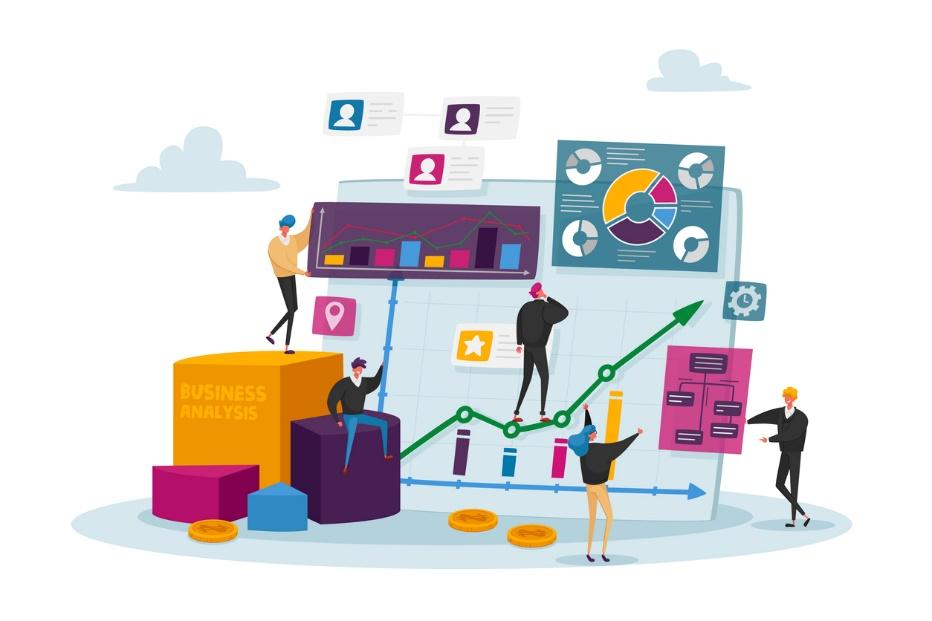Marketing is the way in which companies make their products visible and appealing to potential customers. A business with an effective marketing strategy will talk about its values, its customers, its products, and what they do can help solve problems for those customers.

For many people and almost all business owners, marketing is all about action. You are taking action to get the information about your business in front of as many people as possible. This is where long email lists and campaigns come in. Businesses also use phone calls, knocking on doors, paying for TV and radio advertising, and a strong, SEO-optimized online presence to get their products into the hands of the consumer.
It’s important that marketing strategy is targeted and nuanced. It is not as simple as paying lots of money to get your company name in as many places as possible. While both the quality and the quantity of the marketing you do does matter to a massive degree, constantly moving forward without a strategic plan is bound to fail. For a company to grow and succeed, a marketing strategy that uses data is essential.
Data analysis is a crucial part of any marketing strategy, but it isn’t talked about nearly as much as other elements. So many promising businesses spend hours and hundreds or even thousands of dollars on marketing plans that aren’t working, rather than stepping back for a second and trying to understand why they don’t work. Data analysis can solve this problem.
In order to truly succeed in business and make an impact on the world with whatever your product is, you need to take a step back from aggressive marketing strategies for a second and analyze where you might be going wrong or where improvements could be made.
What is data analytics?
One of the best strategies when it comes to marketing is to tell a story, allowing your customer to be the main character in a tale where they find success using your product. Well, data analysis works the same way. All the marketing you are doing can and should be crunched down into bits of data that you can look at and analyze. This data will tell you the story of your business, show you where you went wrong or which path is best, and lead you to the happy ending of your success.
For example, let’s say that your business sells flower bouquets, and you have a website that is your primary point of contact with your customers. After being in business for a while, you notice that while your business is being talked about on social media, people are reacting to your posts, and everyone seems to love your flowers and the idea of your business, yet no one is buying what you are selling.
You take a look at your website data and notice that thousands of viewers are coming to your website. They like what you have to offer, and a great many of them are going to the pages where you have your fresh-cut flowers available to buy, but no one is making a purchase.
The data tells you a story here. First, your flowers are incredibly popular, and second, the bottleneck is on the pages where you have the flowers to sell because no one is advancing past that point. Having identified this, you can find a solution. In this case, it might be that your pages are poorly written or that the pictures are not of high quality.
The story is that something in your shopping area is broken, and now you need to try different things to fix it. This realization would be impossible without data.
Data allows you to take the correct action
While marketing is all about taking action to get your product in front of customers, it can be a lot like banging your head against a wall if your actions aren’t getting you the results you want. By analyzing the data around both successful and failed marketing schemes, you can see where the bottlenecks are and take action to fix them.
While it might seem like a horrible idea to slow down your marketing campaigns, taking a moment to analyze what is not working so that you can take the best possible action going forward is invaluable.
Data analytics helps you connect with your customer
Another problem that many people have when it comes to marketing for their customers is that they don’t know who their customers are or where to find them. Sure, they might have an idea that their product is made for the average American family, the middle-aged suburban mom, or the technologically gifted child, but getting their product out to that niche of customers can be very difficult.
Data analytics can help you track your customers as they go on the journey to and through your website, and all the information you gain can help you better connect with them. For example, you can see how your customers came to your website, whether that be an advertisement you posted online, by clicking on an embedded link in a third-party article, or by coming from word of mouth.
If you notice that quite a lot of your customers in your niche are coming to your website and your product page from one specific path, you can focus your marketing efforts on that path, increasing the means of getting information to your customers.
Tracking engagement
Both social media websites and email lists can track customer interactions. With the tap of a button, you can see that 1,000 people viewed your email, 700 opened it, and then 400 clicked on the link. Then you can go to your website and follow the path those 400 people took.
You can further understand and predict your customers’ behavior by analyzing this data. For example, you can look at what types of emails and social media posts get the most interaction and the highest response from your customers, and then continue to do those, while phasing the ones with the least attention out of your marketing strategy.
As another example, you might discover that many of your customers might engage with photo-based images of your business and your products on both social media and in emails. You can use data to track that and take advantage of it, and once you get to where you have a product you really want to market, you can preclude your marketing campaign with lots of photo-based posts to appeal to your customers’ preferences.
Discovering what your customers engage with and what they want is one of the best ways to market to them, and you can only do that if you understand the data.
Data is always flowing and never lies
Another big advantage of data is that it is always flowing and never lies to you. Everything you and your customers do are data points that can tell the story of your marketing campaign and your business as a whole. There’s an abundance of data available, and if you can learn to read and analyze it, you can focus on it and take advantage of it.
Businesses will never have to worry about running out of data, having periods of no data (because even that can tell you something), or having any type of data scarcity. Data analysis keeps your finger firmly on the pulse of your business and allows you to constantly act and react to what is going on with your business, your marketing plans, and your customers.
Additionally, data never lies and will never lead you astray. If something isn’t working in your business and you aren’t getting the results you want, the data will tell you why, but it will also provide you with an answer you can use to solve the problem. Data does not have biases and complex emotions as humans do, and it can therefore give a reliable and accurate picture of your business.
How to read and use business data
Now that you know that data analysis can be a massive benefit to almost any business, the question remains—how do you use data? After all, for many people, reading data can seem a lot like reading a foreign language. Even if you understand the data and the marketing behind it, it can still be very hard to properly implement the data into your business and make sure that your solution is effective.
Thankfully there are a few easy ways to get into the world of business data to a point where you understand it. One of these methods is to focus on a career change to marketing. Marketing is the backbone of data, and if business data is like speaking in a different language, then marketing is the ability to speak in the first place. An online master’s such as that offered by St. Bonaventure University will prepare you with the key data analytics skills alongside the key marketing skills needed for a variety of specialisms available in marketing. Marketing is going to teach you not just how to read and understand data but also how to use it in order to reach your customers.
Data analytics and marketing go hand in hand, but there are a few other skills that can ensure you have everything you need to use business data to its fullest extent.
Understanding and empathy
One of the key rules of marketing is that you aren’t selling a service or product, but you are selling the solution to a problem. In order to properly sell the solution to a problem, you need to understand the problem entirely. For example, if your business is selling treadmills, then your primary targets are going to be people who want to work out at home. Their pain points might be that they are overweight or not where they want to be health-wise, and they don’t feel comfortable going to a gym just yet.
This is an example of a pain point and something that you can target in your advertising with as much empathy and emotion as you can.
By putting yourself in the shoes of the consumer and considering what you would need or want if experiencing the same problem as them, you can ensure that you are creating a solution that is realistic and effective. This is why understanding and empathy are so crucial in marketing. It is especially important to apply understanding and empathy to data analysis due to the logical, matter-of-fact nature of data.
Creativity and communication
People get marketed to every single day from countless sources, and many customers have caught wind of the common strategies that companies use to try to get their attention. Those strategies get tuned out rather quickly, and then the prospective customers don’t engage. That is why you need to be able to communicate effectively and be creative in your marketing plans. Creativity doesn’t just mean making a marketing plan look nice, but it also means coming up with out-of-the-box thinking to solve the problems that the data tells you about.
Good communication is not only a way to get your information out to the customer in the shortest possible time but is also a great way to build rapport and empathy as well.
Predict customer behavior
New products come out of the woodwork all the time, as do new ways to market the products that are created. While you can read data to predict the present course of action or to fix past mistakes, the best skill data analysis provides is the ability to predict the future. Being able to read data sets and predict what your customers will do next or what they will best respond to will enable you to get out ahead of your customers and prevent any lulls in your business.
As datasets continue to evolve and receive more inputs as more ways of gathering data become available, you need to ensure that you are growing your skills to further interpret all the data your business is collecting. If you’ve got a growth mindset and the ability to expand your thinking as the field of data analysis expands, you’re giving your business the best chance to succeed. Learning about marketing and data analytics can only improve the success of your business.
Finding success
While it might seem hard to run a business while constantly analyzing data, it is possible. Being both a marketer and a data analyst will only increase your success in your field by allowing you to reach more customers and will ultimately make your business more money.
The important thing is to take your time. Whether you are just starting your business or have a multi-million dollar one, you will initially be presented with the same abundance of data, and you will need to sift through it. Pick one marketing plan that might be working the way you want, or one that may have a hiccup or two, and simply examine the story that the data points are telling you.
Once you have the data analyzed, fix the problem and see if you have found success. If that doesn’t work, read new data points and look at the data from a different perspective. Once you have found the relevant data and worked out how to use it best, focus on your next marketing campaign. Eventually, you’ll have your data reading skills and your business working at full speed, and that can only benefit you and your company.








